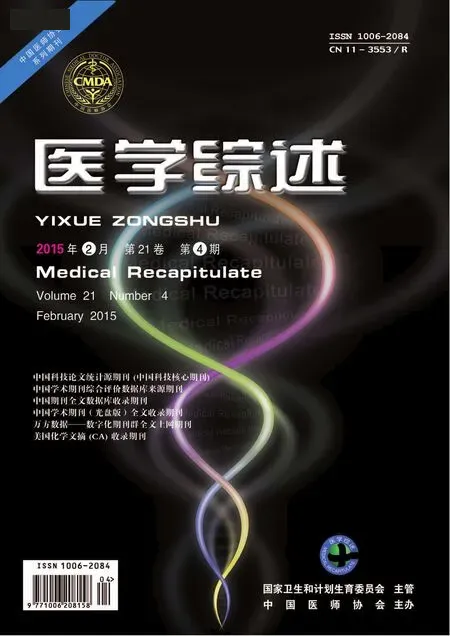提高肝移植边缘供肝质量的研究进展
关 正(综述),吕 毅(审校)
(西安交通大学医学院第一附属医院 a.麻醉科,b.肝胆外科,西安 710061)
提高肝移植边缘供肝质量的研究进展
关正a(综述),吕毅b※(审校)
(西安交通大学医学院第一附属医院 a.麻醉科,b.肝胆外科,西安 710061)
摘要:由于等待肝移植的患者越来越多,而可用于移植的肝脏严重短缺,故提高边缘供肝的质量对于增加供肝来源具有重要意义。提高边缘供肝质量的最新研究包括对供体的药物干预及循环支持、肝脏保存液的改进、机械灌注的尝试和更加合适的保存温度以及气态氧灌注的进一步改进。但其中大部分都局限在动物研究阶段,其与临床应用还存在一定的差距。该文就提高边缘供肝质量的研究新进展予以综述。
关键词:边缘供肝;肝移植;心脏死亡后器官捐献;机械灌注
由于近年来供肝的短缺,严重影响了肝移植的发展,故人们开始使用老年、脂肪变性以及心脏死亡后器官捐献(donation after cardiac death,DCD)肝脏来进行肝移植;使用这类肝脏进行肝移植后原发移植物无功能,出现胆管系统并发症且再次肝移植发生率较高,故这类肝脏被称为边缘供肝[1-3]。Fernandez-Merino等[1]研究发现,进行肝移植患者的生存率与供体年龄呈负相关,移植肝功能也有着同样的规律。脂肪变性肝脏由于严重的线粒体损伤、能量代谢损害以及氧化应激反应的增强导致其对缺血/再灌注损伤的耐受性较差[4]。DCD供肝由于热缺血时间较长,导致了胆管系统并发症发生率明显升高[5]。尽管边缘供肝存在以上的缺陷,但由于肝移植供肝的短缺及等待移植患者的增加,边缘供肝占肝移植供肝的比例仍在逐年升高[6]。因此,如何提高边缘供肝的质量,增加供肝的来源,成为目前研究的热点。
1对肝脏供体的干预
对肝脏供体的干预包括药物干预和循环辅助。前列腺素E1和蛋白酶抑制剂是近年来研究较为广泛的干预药物;前者通过下调黏附分子表达,抑制中性粒细胞向内皮细胞的黏附从而对抗肝脏缺血再灌注损伤[7]。研究表明,给予大鼠10 μg/L的前列腺素E1,心搏停止30 min后切取肝脏,发现肝脏质量明显提高,损伤明显减轻[8-9]。蛋白酶抑制剂通过减轻脂质过氧化反应从而明显降低肝脏再灌注后的转氨酶水平,缩小肝脏坏死面积[10]。利用体外膜肺氧合对循环进行辅助,可恢复由于心搏停止而导致的肝脏细胞内能量的损失;2005年,体外膜肺氧合第一次在DCD供体上作为切取肝脏前的循环辅助应用并获得了成功[11]。Noormohamed等[12]在猪心搏停止后30 min开始给予2 h的体外膜肺氧合,之后切取肝脏,发现亦可提高供肝的质量。
2单纯低温保存的改进
肝脏保存液中加入蛋白酶抑制剂、表皮生长因子和白蛋白可明显提高肝脏保存的效果[13-16]。蛋白酶抑制剂硼替佐米通过提高肝脏抗氧化酶水平来保护慢性酒精性肝损害[13]。在UW液(the university of wisconsin solution,UW)中加入小剂量硼替佐米(100 nmol/L),对有脂肪变性的肝脏在4 ℃下冷保存24 h后,常温再灌注2 h,发现肝脏质量明显提高,损伤明显减轻[14]。Zaouali等[15]给IGL-1液(institute george lopez solution,IGL)中加入10 μg/L的表皮生长因子1,对脂肪变性的肝脏进行离体24 h单纯低温保存;结果发现,与不加表皮生长因子1的肝脏相比,再灌注2 h后,其转氨酶水平下降,胆汁产生增加,且线粒体损伤减轻,氧化应激反应减轻。在UW液中加入白蛋白发现,其具有更好的肝脏保护作用[16];原位末端转移酶标记技术染色发现其完全抑制了细胞凋亡[17]。
3机械灌注下肝脏保存的尝试
机械灌注保存通过下调促炎因子(如肿瘤坏死因子α、白细胞介素8、细胞间黏附分子1)的活性从而提高保存器官的功能[18]。Shigeta等[19]对猪DCD肝脏分别通过门静脉和肝动脉进行持续机械灌注;与单纯低温保存相比,灌注液中天冬氨酸转氨酶及乳酸脱氢酶水平明显降低,且肝脏再灌注后存活率明显提高。Fondevila等[20]对DCD肝脏采用低温机械灌注与低温保存的效果进行了比较,发现接受低温机械灌注移植肝的实验猪5 d生存率提高,生化检查凝血酶原时间明显改善。Vairetti等[21]发现,脂肪肝机械灌注保存效果明显好于低温保存。Guarrera等[22]第一次将低温机械灌注肝脏保存应用于临床,该小组对比了20例分别进行低温机械灌注和单纯低温保存的肝脏质量,发现前者早期移植物无功能比例下降,胆管系统的并发症亦明显降低。机械灌注的缺点是灌注过程中对肝窦内皮细胞的损伤,在灌注液中加入羟乙基淀粉[23]或多巴胺[24]可减轻其对肝窦内皮细胞的损伤,尤其是对DCD供肝。
4边缘供肝保存的合适温度研究
对供肝进行-4 ℃的超低温保存,与传统的4 ℃低温保存相比,肝脏再灌注后天冬氨酸转氨酶、丙氨酸转氨酶及乳酸脱氢酶水平明显下降,组织学检查未发现肝细胞、胆管及血管的损伤[25]。Charrueau等[26]分别于4 ℃、1 ℃及-0.5 ℃对遭遇热缺血15 min的肝脏进行24 h低温保存,发现1 ℃下DCD肝脏保存效果最好,这与1 ℃下肝窦内皮细胞的损伤最轻有关。对DCD肝脏的机械灌注保存研究发现,保持灌注液温度在20 ℃左右时(亚低温),再灌注后丙氨酸转氨酶释放量最低、门静脉阻力最小、胆汁产生量最大[27],肝脏损伤明显减轻[28]、腺苷三磷酸(adenosine triphosphate,ATP)水平明显升高[29]。在对脂肪变性肝脏的保存中亦发现,亚低温机械灌注有减轻肝脏损伤,提高肝脏功能的作用[30]。
5气态氧灌注保存的研究进展
气态氧灌注肝脏保存的效果在动物供肝保存中已得到了验证[31-32],但由于其存在移植后移植物气栓的可能而未得到应用。Treckmann等[33]利用气态氧逆行灌注联合单纯低温保存,使5例由于热缺血损伤而准备舍弃的肝脏作为供肝成功地进行了移植;在2年的随访中,接受这些肝脏患者的肝功能良好,未遭受再次肝移植。在Minor等[34]的研究中,对脂肪变性肝脏在低温保存前给予90 min气态氧灌注,结果肝酶释放、脂质过氧化、细胞凋亡及细胞自我吞噬减少,对氨的代谢、肝脏显微形态及整体代谢状况提高。Koetting等[35]在DCD肝脏低温保存期间给予气态氧灌注,发现肝细胞损伤明显减少。以上研究均提示气态氧灌注作为肝脏保存的辅助手段,具有一定的应用价值。
6预防器官缺血/再灌注损伤的研究进展
DCD供肝由于反复的缺血/再灌注损伤而导致移植物存活率下降,缺血性胆管病的发病率增加;而脂肪变性供肝及老年供肝易受缺血/再灌注损伤的影响,因此,将预防器官缺血/再灌注的方法应用于对边缘供肝获取前供体的干预,有可能提高边缘供肝的质量。
6.1远端缺血预处理在器官缺血/再灌注损伤中的应用远端缺血预处理是指对一个脏器的缺血预处理会引起远隔脏器的缺血耐受[36]。临床上采用对一侧肢体进行5 min缺血5 min再灌注的缺血/再灌注处理,使机体产生启动因子(如腺苷、一氧化氮、缓激肽、阿片类物质等),其通过体液因子介导或神经通路(如蛋白激酶C和ATP敏感性钾离子通道)达到对远隔器官的保护作用。Kanoria等[37]研究发现,对兔后肢行3个循环的5 min缺血5 min再灌注,能降低全肝缺血/再灌注损伤。但是,如何实现远端缺血预处理对靶器官的最佳保护强度(包括最佳循环次数,缺血时间等)还需要进一步研究;远端缺血预处理是否会造成局部组织损伤也还需要大量临床试验来验证。
6.2嘌呤能信号转导在器官缺血/再灌注损伤中的应用经由ATP参与的嘌呤能信号转导及腺苷受体是目前对抗器官缺血/再灌注损伤的最新治疗靶点[38]。在器官缺血情况下,细胞释放ATP到细胞外,激活细胞外的ATP受体,后者激活炎性反应,导致器官在缺血状态下的损伤;同时,释放到细胞外的ATP又会很快地转化为腺苷,其作用与ATP受体相反,具有器官保护作用[39]。因此,作用于此代谢通路上的药物被认为具有对抗器官缺血/再灌注损伤的作用(如ATP受体拮抗剂等);加速ATP向腺苷转化的药物有ATP双磷酸酶、核苷酸酶、缺氧诱导因子等[40]。但目前还需要大量临床随机对照试验的验证,才能使其进入临床应用。
6.3血红素氧合酶1/一氧化碳体系在器官缺血/再灌注损伤中的应用血红素氧合酶1/一氧化碳体系分布于所有的组织和器官,其具有抗氧化应激、抗细胞凋亡和抗炎症反应的作用[41]。血红素氧合酶1/一氧化碳体系对冷保存肝脏具有保护作用,可显著延长其保存时间,并通过减少巨噬细胞浸润、抗细胞凋亡作用对移植肝脏出现的缺血/再灌注产生保护作用,提高器官移植后的存活率[42]。
7小结
提高边缘供肝的质量,可明显增加肝移植供肝的来源,缓解供肝短缺的问题。近年来人们尝试了多种新的保存药物、保存技术,甚至各种保存温度对边缘供肝进行了保存,取得了一定的进展。另外,在对抗器官的缺血再灌注损伤方面,近年来亦有了一些新的进展,但距进入临床应用还存在一定的距离,且目前仍未见到对于老年供肝保存的研究,还需进一步深入研究。
参考文献
[1]Fernandez-Merino FJ,Nuno-Garza J,Lopez-Hervas P,etal.Donor age as a risk factor for patient survival in the liver transplant[J].Transplant Proc,2003,35(5):1795-1797.
[2]McCormack L,Dutkowski P,El-Badry AM,etal.Liver transplantation using fatty livers:always feasible?[J].J Hepatol,2011,54(5):1055-1062.
[3]Merion RM,Pelletier SJ,Goodrich N,etal.Donation after cardiac death as a strategy to increase deceased donor liver availability[J].Ann Surg,2006,244(4):555-562.
[4]Selzner M,Clavien PA.Fatty liver in liver transplantation and surgery[J].Semin Liver Dis, 2001,21(1):105-113.
[5]Foley DP,Fernandez LA,Leverson G,etal.Biliary complications after liver transplantation from donation after cardiac death donors:an analysis of risk factors and long-term outcomes from a single center[J].Ann Surg,2011,253(4):817-825.
[6]Grewal HP,Willingham DL,Nguyen J,etal.Liver transplantation using controlled donation after cardiac death donors:an analysis of a large single center experience[J].Liver Transpl,2009,15(9):1028-1035.
[7]Hafez T,Moussa M,Nesim I,etal.The effect of intraportal prostaglandin E1 on adhesion molecule expression,inflammatory modulator function,and histology in canine hepatic ischemia/reperfusion injury[J].J Surg Res,2007,138(1):88-99.
[8]Hara Y,Akamatsu Y,kobayashi Y,etal.Perfusion using oxygenated buffer containing prostaglandin E1 before cold preservation prevents warm ischemia-reperfusion injury in liver grafts from non-heart-beating donors[J].Transplant Proc,2010,42(10):3973-
3976.
[9]Hara Y,Akamatsu Y,Maida K,etal.A new liver graft preparation method for uncontrolled non-heart-beating donors,combining short oxygenated warm perfusion and prostaglandin E1[J].J Surg Res,2013,184(2):1134-1142.
[10]Padrissa-Altes S,Zaouali MA,Boncompagni E,etal.The use of a reversible proteasome inhibitor in a model of Reduced-Size Orthotopic Liver transplantation in rats[J].Exp Mol Pathol,2012,93(1):99-110.
[11]Wang CC,Wang SH,Lin CC,etal.Liver transplantation from an uncontrolled non-heart-beating donor maintained on extracorporeal membrane oxygenation[J].Transplant Proc,2005,37(10):4331-
4333.
[12]Noormohamed MS,Kanwar A,Ray C,etal.Extracorporeal membrane oxygenation for resuscitation of deceased cardiac donor livers for hepatocyte isolation[J].J Surg Res,2013,183(2):39-48.
[13]Bardag-Gorce F.Proteasome inhibitor treatment in alcoholic liver disease[J].World J Gastroenterol,2011,17(20):2558-2562.
[14]Zaouali MA,Bardag-Gorce F,Carbonell T,etal.Proteasome inhibitors protect the steatotic and non-steatotic liver graft against cold ischemia reperfusion injury[J].Exp Mol Pathol,2013,94(2):352-359.
[15]Zaouali MA,Ben Mosbah I,Padrissa-Altes S,etal.Relevance of epidermal growth factor to improve steatotic liver preservation in IGL-1 solution[J].Transplant Proc,2010,42(8):3070-3075.
[16]Abbas R,Kombu RS,Dignam D,etal.Polyethylene glycol modified-albumin enhances the cold preservation properties of University of Wisconsin solution in rat liver and a hepatocyte cell line[J].J Surg Res,2010,164(1):95-104.
[17]Ishima Y,Shinagawa T,Yoneshige S,etal.UW solution improved with high anti-apoptotic activity by S-nitrosated human serum albumin[J].Nitric Oxide,2013,30:36-42.
[18]Guarrera JV,Henry SD,Chen SW,etal.Hypothermic machine pre-servation attenuates ischemia/reperfusion markers after liver transplantation:preliminary results[J].J Surg Res,2011,167(2):365-
373.
[19]Shigeta T,Matsuno N,Obara H,etal.Functional recovery of donation cardiac death liver graft by continuous machine perfusion preservation in pigs[J].Transplant Proc,2012,44(4):946-947.
[20]Fondevila C,Hessheimer AJ,Maathuis MH,etal.Hypothermic oxygenated machine perfusion in porcine donation after circulatory determination of death liver transplant[J].Transplantation,2012,94(1):22-29.
[21]Vairetti M,Ferrigno A,Rizzo V,etal.Subnormothermic machine perfusion protects against rat liver preservation injury:a comparative evaluation with conventional cold storage[J].Transplant Proc,2007,39(6):1765-1767.
[22]Guarrera JV,Henry SD,Samstein B,etal.Hypothermic machine preservation in human liver transplantation:the first clinical series[J].Am J Transplant,2010,10(2):372-381.
[23]Xu H,Zhang JX,Jones JW,etal.Hypothermic machine perfusion of rat livers preserves endothelial cell function[J].Transplant Proc,2005,37(1):335-337.
[24]Minor T,Luer B,Efferz P.Dopamine improves hypothermic machine preservation of the liver[J].Cryobiology,2011,63(2):84-89.
[25]Monzen K,Hosoda T,Hayashi D,etal.The use of a supercooling refrigerator improves the preservation of organ grafts[J].Biochem Biophys Res commun,2005,337(2):534-539.
[26]Charrueau C,Neveux N,Chaumeil JC,etal.Best temperature for static liver graft storage is 1℃[J].J Surg Res,2013,180(2):322-329.
[27]Olschewski P,Gass P,Ariyakhagorn V,etal.The influence of storage temperature during machine perfusion on preservation quality of marginal donor livers[J].Cryobiology,2010,60(3):337-343.
[28]Gringeri E,Bonsignore P,Bassi D,etal.Subnormothermic machine perfusion for non-heart-beating donor liver grafts preservation in a Swine model:a new strategy to increase the donor pool? [J].Transplant Proc,2012,44(7):2026-2028.
[29]Ferrigno A,Rizzo V,Boncompagni E,etal.Machine perfusion at 20℃ reduces preservation damage to livers from non-heart beating donors[J].Cryobiology,2011,62(2):152-158.
[30]Vairetti M,Ferrigno A,Carlucci F,etal.Subnormothermic machine perfusion protects steatotic livers against preservation injury:a potential for donor pool increase?[J].Liver Transpl,2009,15(1):20-29.
[31]Minor T,Isselhard W.Synthesis of high energy phosphates during cold ischemic rat liver preservation with gaseous oxygen insufflation[J].Transplantation,1996,61(1):20-22.
[32]Minor T,Saad S,Nagelschmidt M,etal.Successful transplantation of porcine livers after warm ischemic insult in situ and cold preservation including postconditioning with gaseous oxygen[J].Transplantation,1998,65(9):1262-1264.
[33]Treckmann J,Minor T,Saad S,etal.Retrograde oxygen persufflation preservation of human livers:a pilot study[J].Liver Transpl,2008,14(3):358-364.
[34]Minor T,Stegemann J,Hirner A,etal.Impaired autophagic clearance after cold preservation of fatty livers correlates with tissue necrosis upon reperfusion and is reversed by hypothermic reconditioning[J].Liver Transpl,2009,15(7):798-805.
[35]Koetting M,Dombrowski F,Minor T.No synergistic effect of carbon monoxide and oxygen during static gaseous persufflation preservation of DCD liver[J].J Surg Res,2011,171(2):859-864.
[36]Tapuria N,Kumar Y,Habib MM,etal.Remote ischemic preconditioning:a novel protective method from ischemia reperfusion injury-a review[J].J Surg Res,2008,150(2):304-330.
[37]Kanoria S,Jalan R,Davies NA,etal.Remote ischaemic preconditioning of the hind limb reduces experimental liver warm ischaemia-reperfusion injury[J].Br J Surg,2006,93(6):762-768.
[38]Eltzschig HK,Sitkovsky MV,Robson SC.Purinergic signaling during inflammation[J].N Engl J Med,2012,367(24):2322-2333.
[39]Colgan SP,Eltzschig HK.Adenosine and hypoxia-inducible factor signaling in intestinal injury and recovery[J].Annu Rev Physiol,2012,74:153-175.
[40]Zhong Z,Ramshesh VK,Rehman H,etal.Activation of the oxygen-sensing signal cascade prevents mitochondrial injury after mouse liver ischemia-reperfusion[J].Am J Physiol Gastrointest Liver Physiol,2008,295(4):823-832.
[41]Chen X,Su C,Zhang ZY,etal.Hemo oxygenase-1 induction in vitro and in vivo can yield pancreas islet xenograft survival and improve islet function[J].Chin Med J(Engl),2011,124(20):3378-3385.
[42]Kato H,Amersi F,Buelow R,etal.Hemo oxygenase-1 overexpression protects livers from ischemia/reperfusion injury with extended cold preservation[J].Am J Transplant,2001,1(2):121-128.
The Research Progress of Improving the Quality of the Marginal Donor Liver in Liver Transplantation
GUANZhenga,LVYib.
(a.DepartmentofAnesthesiology,b.DepartmentofHepatobiliarySurgery,theFistHospitalAffiliatedtoXi′anJiaotongUniversity,Xi′an710061,China)
Abstract:There is a contradiction between the increasing patients waiting for liver transplantation and the shortage of donor liver,it is important to increasing the number of donor livers by improving the quality of the marginal donor liver.The new researches of improving the quality of the marginal donor liver include:the medication and the circulation support for the donor,the modified preserving solution,the use of machine perfusion preservation,the research of the best temperature for liver graft storage and the improving of gaseous oxygen perfusion.However,most of the researches are still in animal experiment stage,where a certain gap still exist to clinical application.Here is to make a review of the recent progress in improving the quality of marginal donor liver.
Key words:Marginal donor liver; Liver transplantation; Donation after cardiac death; Machine perfusion
收稿日期:2014-04-10修回日期:2014-08-07编辑:郑雪
doi:10.3969/j.issn.1006-2084.2015.04.037
中图分类号:R657.3
文献标识码:A
文章编号:1006-2084(2015)04-0671-04

